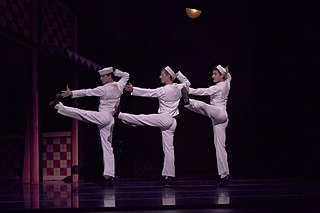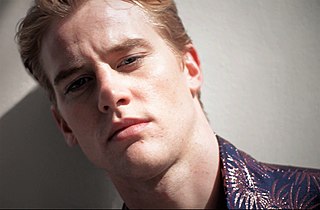Related Research Articles

New York City Ballet (NYCB) is a ballet company founded in 1948 by choreographer George Balanchine and Lincoln Kirstein. Balanchine and Jerome Robbins are considered the founding choreographers of the company. Léon Barzin was the company's first music director. City Ballet grew out of earlier troupes: the Producing Company of the School of American Ballet, 1934; the American Ballet, 1935, and Ballet Caravan, 1936, which merged into American Ballet Caravan, 1941; and directly from the Ballet Society, 1946.

Jerome Robbins was an American dancer, choreographer, film director, theatre director and producer who worked in classical ballet, on stage, film, and television.
Le Baiser de la fée is a neoclassical ballet in one act and four scenes composed by Igor Stravinsky in 1928 and revised in 1950 for George Balanchine and the New York City Ballet. Based on Hans Christian Andersen's short story Isjomfruen, the work is an homage to Pyotr Ilyich Tchaikovsky, for the 35th anniversary of the composer's death. Stravinsky elaborated several melodies from early piano pieces and songs by Tchaikovsky in his score. A commission by Ida Rubinstein from 1927, the ballet was choreographed by Bronislava Nijinska and premiered in Paris on 27 November 1928.
Jewels is a three-act ballet created for the New York City Ballet by co-founder and founding choreographer George Balanchine. It premièred on Thursday, 13 April 1967 at the New York State Theater, with sets designed by Peter Harvey and lighting by Ronald Bates.
Brandenburg is a neoclassical ballet choreographed by Jerome Robbins to compositions by Johann Sebastian Bach. Danced by a cast of twenty, the plotless ballet is set to Bach's Brandenburg Concerto No. 3, as well as individual movements from Brandenburg Concertos Nos. 1, 2 and 6. The ballet premiered on January 22, 1997, at the New York State Theater, danced by the New York City Ballet. Brandenburg is Robbins' last work.
Symphony in C, originally titled Le Palais de Cristal, is a ballet choreographed by George Balanchine, to Georges Bizet's Symphony in C. The ballet was originally created for the Paris Opera Ballet, and premiered on July 28, 1947 at Théâtre National de l'Opéra.
N.Y. Export: Opus Jazz is a jazz ballet made by Jerome Robbins, subsequently ballet master of New York City Ballet (NYCB) to music of the same title by Robert Prince. The premiere took place on 8 June 1958 at the Festival of the Two Worlds in Spoleto, performed by Ballets: USA and subsequently on Broadway. The NYCB premiere was on 29 April 2005 at the New York State Theater, Lincoln Center, with scenery by Ben Shahn, costumes by Florence Klutz and lighting by Jennifer Tipton.

Fancy Free is a ballet composed in 1944 by Leonard Bernstein. The Ballet Theatre premiered the ballet with choreography by Jerome Robbins, scenery by Oliver Smith, costumes by Kermit Love, and lighting by Ronald Bates. The premiere took place on Tuesday, 18 April 1944 at the old Metropolitan Opera House, New York. The New York City Ballet premiere took place on Thursday, 31 January 1980. Fancy Free provided the basis for the later musical, On the Town. A portion of the score was also used in the opening scenes of Alfred Hitchcock's Rear Window.
Bugaku is a ballet made by New York City Ballet co-founder and ballet master George Balanchine to eponymous music by Toshiro Mayuzumi, commissioned by City Ballet in 1962. The premiere took place on 30 March 1963 at City Center of Music and Drama, New York, with scenery by David Hays, costumes by Karinska, and lighting by Ronald Bates. NYCB had toured Japan in 1958 and the Gagaku Company of the Imperial Household toured the US the following year.
Mother Goose is a ballet made for New York City Ballet's Ravel Festival by balletmaster Jerome Robbins to Ravel's music and scenario, the Ma Mère l'Oye Suite from 1908, orchestrated by the composer in 1912. The premiere took place on May 22, 1975, at the New York State Theater, Lincoln Center, with costumes by Stanley Simmons and lighting by Jennifer Tipton. At its premiere it bore the French title, which was retained when it was first revived in January 1978 but anglicized by May of that year.
In the Night is a ballet choreographed by Jerome Robbins to four nocturnes by Frédéric Chopin. It premiered on January 29, 1970 at the New York State Theater, performed by the New York City Ballet.
Union Jack is a ballet made by New York City Ballet co-founder and founding choreographer George Balanchine to traditional British tunes, hornpipe melodies and music-hall songs, ca. 1890–1914, adapted by Hershy Kay. The premiere took place on 13 May 1976, at the New York State Theater, Lincoln Center, to honor British heritage in the United States its bicentennial with costumes by Rouben Ter-Arutunian, original lighting by Ronald Bates and current lighting by Mark Stanley. At the finale the ensemble spells out "God Save the Queen" in semaphore code and the Union Jack unfurls. Principal dancer Jock Soto included an excerpt from Union Jack in his farewell performance in June 2005.
Ives, Songs is a ballet made by New York City Ballet ballet master Jerome Robbins to songs of Charles Ives:
Prodigal Son, or Le Fils prodigue, Op. 46 is a ballet created for Diaghilev's Ballets Russes by George Balanchine to music by Sergei Prokofiev (1928–29). The libretto, based on the parable in the Gospel of Luke, was by Boris Kochno, who added a good deal of drama and emphasized the theme of sin and redemption ending with the Prodigal Son's return.
Glass Pieces is a ballet choreographed by Jerome Robbins to music by Philip Glass, costumes designed by Ben Benson, lighting designed by Ronald Bates and production designed by Robbins and Bates. The ballet was premiered on May 12, 1983, at the New York State Theater, performed by the New York City Ballet.
Hallelujah Junction is the eighth ballet made by New York City Ballet ballet master in chief Peter Martins to John Adams' eponymous music. The duo pianists appear in silhouette above the dancers throughout in Mark Stanley's lighting. The dance was made on the Royal Danish Ballet. The premiere took place on 24 March 2001 at the Royal Danish Theatre, Copenhagen. The NYCB premiere was on 22 January 2002 at the New York State Theater, Lincoln Center.
Chaconne is a ballet made by New York City Ballet co-founder and ballet master George Balanchine to ballet music from Gluck's Orfeo ed Euridice. The premiere took place Wednesday, 22 January 1976 at the New York State Theater, Lincoln Center, with lighting by Ronald Bates; Robert Irving conducted. Chaconne was danced in practice clothes at its premiere; Karinska's costumes were added in the spring season.

Chase Finlay is a former ballet dancer and former principal dancer with the New York City Ballet who has also danced with the Mariinsky Theatre in Russia.
Maria Calegari is an American ballet dancer, teacher and répétiteur. She joined the New York City Ballet in 1974 and became a principal dancer in 1983. She left the company in 1994, then occasionally performed until 2004. She also teaches ballet and began working as a répétiteur for the Balanchine Trust and Robbins Rights Trust in 1996 and 2003 respectively.
Divertimento No. 15 is a ballet choreographed by George Balanchine to Mozart's eponymous music. The ballet was made for the New York City Ballet. Balanchine first choreographed the score in 1952, for a ballet titled Caracole. In 1956, he planned to revive Caracole for a celebration of Mozart's bicentenary but made a new ballet to the same music instead. Divertimento No. 15 premiered on May 31, 1956, at the American Shakespeare Theatre, Stratford, Connecticut.
References
- Repertory Week, NYCB, Spring season, 2008 repertory, week 5
- Playbill , NYCB, Friday, May 30, 2008